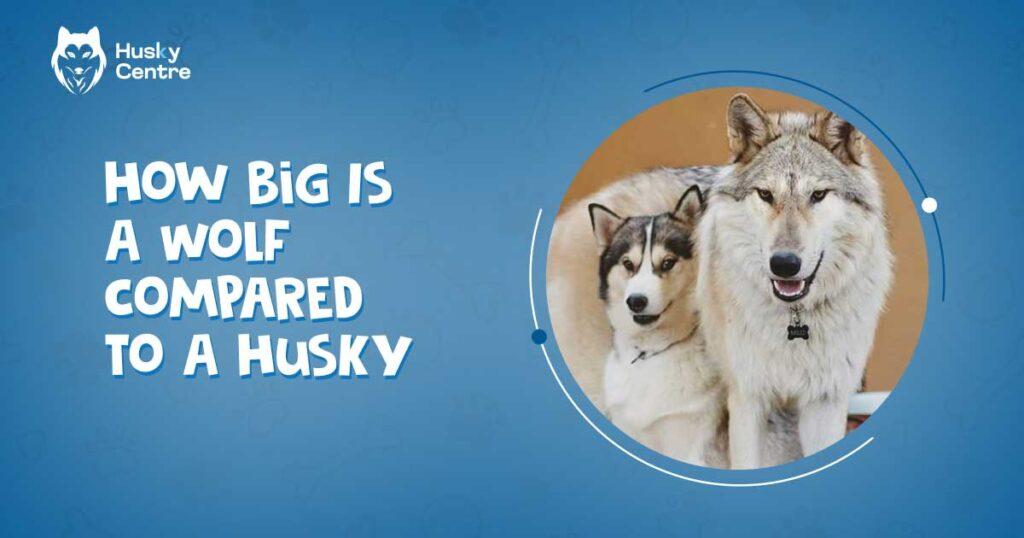Wolves are generally larger than huskies. A wolf can weigh between 60 to 175 pounds, while a husky weighs 35 to 60 pounds.
Wolves and huskies, though similar in appearance, differ significantly in size. Wolves are much larger, more powerful, and built for survival in the wild. They possess a more robust physique, longer legs, and a broader head. Huskies, on the other hand, are medium-sized domestic dogs bred for endurance and speed.
They have a friendly demeanor and are often used as sled dogs. Understanding the size difference between wolves and huskies is essential for recognizing their distinct roles and characteristics. While both species share a common ancestry, their evolution has led to notable physical and behavioral differences.
Physical Characteristics Of Wolves
Wolves are majestic creatures often compared to domestic dogs like Huskies. Understanding the physical characteristics of wolves can help highlight the differences.
Let’s delve into the physical traits of wolves to see how they compare in terms of size, weight, body structure, and variations among species.
Size And Weight
Wolves are generally larger than Huskies. A full-grown wolf can weigh between 70 to 150 pounds, while Huskies usually weigh between 35 to 60 pounds.
Wolves also stand taller, measuring 26 to 32 inches at the shoulder. In contrast, Huskies typically measure 20 to 23.5 inches at the shoulder.
Here is a comparison table for clarity:
| Animal | Weight | Height at Shoulder |
| Wolf | 70 – 150 pounds | 26 – 32 inches |
| Husky | 35 – 60 pounds | 20 – 23.5 inches |
This size difference means wolves are not only heavier but also taller than Huskies.
Body Structure
Wolves have a more robust and muscular build compared to Huskies. Their legs are longer, aiding in long-distance travel. Wolves also have larger feet, which help them walk on snow more efficiently.
In contrast, Huskies have a more compact body structure, adapted for pulling sleds rather than long treks. Their fur is dense and double-layered, designed to withstand cold weather.
Some key differences in body structure include:
- Leg Length: Wolves have longer legs for covering vast distances.
- Foot Size: Wolves have larger feet for better traction on snow.
- Fur: Both have thick fur, but Husky fur is more specialized for insulation.
These differences make wolves more suited to wild terrains, while Huskies excel in controlled environments.
Variations Among Wolf Species
Wolves come in various species, each with unique characteristics. The most common species include the Gray Wolf, Arctic Wolf, and Red Wolf.
The Gray Wolf is the largest, often weighing up to 150 pounds. They have a diverse range, from forests to tundras.
The Arctic Wolf is smaller, adapted to cold climates. They usually weigh around 70 to 125 pounds and have thicker fur. The Red Wolf is the smallest, weighing 50 to 80 pounds and is found in the southeastern United States.
Here is a comparison table for these species:
| Wolf Species | Weight | Habitat |
| Gray Wolf | 70 – 150 pounds | Forests, Tundras |
| Arctic Wolf | 70 – 125 pounds | Arctic Regions |
| Red Wolf | 50 – 80 pounds | Southeastern U.S. |
These variations highlight the adaptability of wolves to different environments, making them one of the most versatile predators in the wild.
Physical Characteristics Of Huskies
When comparing wolves and huskies, their physical characteristics tell a fascinating story. Huskies, known for their striking appearance and friendly demeanor, share some similarities with wolves but also have distinct differences. This section dives deep into the physical characteristics of huskies.
Size And Weight
Huskies are medium-sized dogs, making them quite different from their larger wolf counterparts. Here are some key points to consider:
- Adult male huskies typically weigh between 45 to 60 pounds (20 to 27 kg).
- Adult female huskies usually weigh between 35 to 50 pounds (16 to 23 kg).
- The average height for a male husky ranges from 21 to 23.5 inches (53 to 60 cm).
- Females stand slightly shorter, averaging 20 to 22 inches (51 to 56 cm).
Wolves, in contrast, are generally larger. A male wolf can weigh up to 175 pounds (79 kg) and stand around 32 inches (81 cm) tall at the shoulder. Clearly, there is a significant size difference between the two species.
Body Structure
Huskies have a distinct body structure that suits their working dog heritage. Some of their key body features include:
- Thick fur coats that keep them warm in cold climates.
- Double-layered fur with a soft undercoat and a tougher outer coat.
- Erect, triangular ears that are well-insulated.
- Almond-shaped eyes that can be blue, brown, or even one of each.
Huskies have a muscular build, yet they are more agile and lighter than wolves. Their tails are bushy and often curl over their backs, giving them a friendly appearance. Wolves, on the other hand, have leaner, longer bodies designed for endurance and stealth.
Breed Variations
Huskies come in various types, each with unique characteristics:
- Siberian Huskies: The most common type, known for their speed and endurance.
- Alaskan Huskies: Bred primarily for sled racing, they are not a purebred and can vary in appearance.
- Mackenzie River Huskies: Larger and stronger, used for pulling heavy loads.
Each breed variation has slight differences in size, weight, and body structure. Siberian Huskies, for instance, are more compact and lighter than Alaskan Huskies. Breed variations also affect their coat colors and patterns, adding to their unique appearances.
Comparison Of Size Between Wolves And Huskies
Wolves and huskies may look alike, but they are quite different in size. Comparing these two canines helps to understand their unique characteristics. This section will dive into the size differences between wolves and huskies.
Height And Length
Wolves are generally taller and longer than huskies. Wolves have an average height of 26 to 32 inches at the shoulder, while huskies stand around 20 to 23.5 inches. This height difference makes wolves look more imposing.
In terms of length, wolves also have the upper hand. Wolves can be up to 6.5 feet long, including their tail. Huskies, on the other hand, typically measure up to 4.5 feet in length.
| Animal | Average Height (inches) | Average Length (feet) |
| Wolf | 26-32 | 6.5 |
| Husky | 20-23.5 | 4.5 |
The height and length of wolves give them a more dominant and intimidating appearance compared to huskies. This size advantage is one of the key differences between the two animals.
Weight Differences
Weight is another significant factor where wolves and huskies differ. Wolves weigh between 70 to 145 pounds. Huskies, though robust, weigh considerably less. A typical husky weighs between 35 to 60 pounds.
This weight difference becomes evident when observing their physical presence. Wolves appear more muscular and bulky, while huskies have a more compact build. This difference in weight also affects their agility and endurance.
- Wolf: 70-145 pounds
- Husky: 35-60 pounds
Wolves’ heavier weight contributes to their strength and hunting abilities. Huskies, while lighter, are known for their speed and stamina. This weight contrast highlights the functional adaptations of each species.
Body Structure And Musculature
Wolves and huskies have distinct body structures. Wolves have a leaner and more elongated body. This structure aids in their endurance and ability to cover long distances.
In contrast, huskies have a more compact and sturdy build. This makes them well-suited for pulling sleds over shorter distances. The musculature of wolves is more defined, giving them the power needed for hunting.
Here is a comparison of their body structures:
- Wolf Body Structure: Lean, elongated, and muscular
- Husky Body Structure: Compact, sturdy, and agile
Wolves’ legs are longer and more powerful. This helps them to chase prey effectively. Huskies have shorter legs but are built for speed and endurance.
This difference in body structure and musculature highlights the evolutionary paths of these two canines.
Behavioral And Environmental Influences On Size
Wolves and Huskies often get compared due to their similar appearances, but they differ in size. These differences are influenced by various behavioral and environmental factors.
Understanding the behavioral and environmental influences on size helps explain why wolves are generally larger than Huskies.
Diet And Habitat
Diet and habitat play crucial roles in determining the size of wolves and Huskies. Wolves live in the wild and have a diet rich in protein from hunting large prey like deer, elk, and moose. This high-protein diet supports their growth and strength, making them larger than domesticated dogs like Huskies.
Huskies, on the other hand, usually eat commercial dog food, which may not always be as protein-rich. Their diet is more controlled and less varied compared to wolves. This limited diet influences their overall size and muscle development.
Habitat also impacts size. Wolves roam vast territories and are always on the move, which helps them build muscle and stay fit. They adapt to harsh environments, which demands a strong and robust physique.
In contrast, Huskies live in homes or controlled environments. They may get regular exercise, but it doesn’t compare to the rigorous activity of a wild wolf. The controlled habitat and less demanding lifestyle contribute to their smaller size.
| Factor | Wolf | Husky |
| Diet | High-protein from wild prey | Commercial dog food |
| Habitat | Wild, vast territories | Controlled environments |
Role Of Domestication
Domestication has a significant impact on the size of Huskies compared to wolves. Wolves are wild animals with no human intervention in their growth and development. They have evolved to be larger and stronger to survive in the wild.
Huskies, as domesticated dogs, have undergone selective breeding. Humans have bred them for specific traits like friendliness, size, and behavior.
This selective breeding has influenced their size, making them smaller than their wild counterparts.
Domesticated dogs like Huskies also have a more predictable lifestyle. They receive regular meals, medical care, and a safe living environment.
This controlled lifestyle reduces the need for the robust physique seen in wolves.
Wolves face constant challenges in the wild, from hunting prey to defending their territory. These challenges require them to be larger and more muscular.
Domestication removes these challenges for Huskies, contributing to their smaller size.
Selective breeding focuses on traits favorable for living with humans. For Huskies, this often means a more manageable size and temperament.
This breeding process results in a significant size difference between domesticated Huskies and wild wolves.
- Wolves: Evolved naturally, no human intervention.
- Huskies: Selective breeding, human intervention.
- Lifestyle: Predictable and safe for Huskies, challenging and demanding for wolves.
Frequently Asked Questions
How Big Is A Full Grown Wolf?
A full-grown wolf typically weighs between 70-120 pounds and measures about 4. 5-6 feet in length, including the tail.
How Much Bigger Is A Grey Wolf To A Husky?
A Grey wolf typically weighs between 70-145 pounds. A husky weighs between 35-60 pounds. Wolves are generally larger.
How Big Is A Wolf Compared To A German Shepherd?
Wolves are generally larger than German Shepherds. Wolves can weigh between 70-150 pounds, while German Shepherds typically weigh 50-90 pounds.
How Much Wolf Is In A Husky?
Huskies share about 1-2% of their DNA with wolves. They are primarily domesticated dogs and not wolf hybrids.
Conclusion
Understanding the size difference between wolves and huskies helps appreciate their unique characteristics. Wolves are larger and more robust. Huskies, though smaller, are agile and friendly. Both animals share fascinating traits and differences. This knowledge enhances your appreciation for these remarkable creatures.
Share this insight with fellow animal enthusiasts.


Meet Jarred, the heart and soul behind HukyCentre. With a deep affection for furry friends, he pours his passion into every word he writes. His genuine love for dogs shines through in his engaging and informative content. As a dedicated dog enthusiast, Jarred’s goal is to share valuable insights and tips that resonate with fellow dog lovers. Join Jarred on the journey as he celebrates the joy and companionship that dogs bring into our lives.



